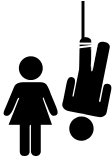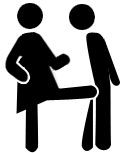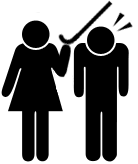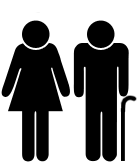







Emily owns this blog which is supposedly Maxinne's.
This blog is also supposedly for schoolwork. Well you know what. That is a load of sheep poo because, yeah, no.
Sorry Sir. (:
Development Methodology.
Note: T_T;;; editted this post before..full had information...but then apparently it didn't post :\ there goes an hour worth of notes -.-;; gah.

System Development Methodology:
> As a noun: framework that is used to structure, plan, and control the process of developing an information system. This structure affects pre-definition of specific aspects that are created and completed by developers in order to create or maintain an application. One method may not be suited to all kinds of prjects, each framework are best suited to specific projects - it's usability depending on various technical, organizational, project and team consideration. Examples of frameworks include:
- Rational Unified Process - since 1998
- Agile Unified Process - since 2005 by Scott Ambler
- Integrated IT Methodology - since 2007
As a verb: an approach used to apply the software framework, and the main approaches are:
- Waterfall: Sequential development approach (linear framework) where development flows steadily downwards through phrases of requirements analysis, design, implmentation, testing (validation), integration, and maintenance. Basic principles involve:
> Division of phrases - with some overlap and splashback
> Planning - time schedules, target dates, budgets and implemenation of an entire system at one time
> Maintenance of control - extensive written doucmentation, as well as formal reviews and approval/signoff by mangaging developer at the end of each stage. - Prototyping: Creation of prototypes (no surprise there...) and basic principles are:
> Handling selected portions - not a standalone, complete development
> Attempts to reduce inherent risk - breaking project into smaller segments and providing more "ease-of-change" during development
> High user involvement- increase likelhood of user acceptance of the final implementation
> Small scale mock-ups
> Basic understand of fundamental business problem - to avoid the wrong problem - Spiral: Combining elements of both design and prototyping in stages, basic principles are:
> Focus on risk assessment - minimizing project risk through breaking project into smaller portions
> "Each cycle involves a progression through the same process of steps..." - each stage has its own elaboration, showing in detail the parts of the project
> Four basic qudrants - 1: Determine objectives, alternatives and constraints 2: Evaluate alternatives, idenify and resolve risks 3: Develop and verify deliberables 4: Plan the next stage - Rapid Application Developlment (RAD): Involves iterative development and uses the construction of prototypes. Basic principles:
> Fast development and delivery, with high quality and low cost
> Reduce project risks - breaking the project down
> Emphasis on fulfilling bussiness need - technological or engineering excellence is of lesser importance
> Joint Application Development (JAD) - users are involved in system design, either through consesus in workshops, or electronically operated interaction
> Produces documentation necessary to support future development and maintenance
Agile Software Development
A group of software development methodologies, where requriements and solutions evolve through collaboration between self-organizing cross-functional teams (group of people with different expertise working toward a common goal). Generally promote a disciplined project management process that encourages frequent inspection and adpation, a leadership philosphy that encourages teamwork, self-organization and accountability.
There are numerous agile development methods, however most promote development, teamwork, collaboration and process adaptability throughout the life-cycle of the project. They break tasks into small portions with minimal planning, and do not irectly involve long-term planning.
Iterations are short time frames that typically last for one to four week, and each part involes a team working through a full software development cycle including planning, requirements analysis, design, codingm unit testing, and acceptance testing when product is demostrated to stakeholders.
Agile Software Development methods are fall in the 'adaptive' side of developments, and so concentrate on adapting quickly to changing realities, there when the needs of a project change, an adaptive team changes as well. In contrast the 'predictive' methods focus on planning the future in detail, therefore team members would be able to report exactly what features and tasks are planned for the entire lenght of the development process.
An iterative development model
 Emily is cool. <- look here (:
Emily is cool. <- look here (:
Labels: multimedia, notes
Warning: Monday Morning, First Period - this post therefore has many personalities clashing to show themselves :)
[Post filled with bs, no grammar, no logic, no sense whatsoeverrrr.]
Okay we shall start off with...
This assignment took an epic amount of time to design, which ended up eating all our time..actually getting the information down was the easy part.
Anyways...
Evaluation
Our multimedia system...although fulfils most of the criteria nescessary for it to be considered a multimedia system - i.e. interactive nature, using text, images, videos, audio - and so it's a success(?). We explored multimedia systems, and any issues regarding them - featured in Applications page.
We could've used our time more wisely, instead of concentrating on the decorative part of the site -Emily!!!!!!!!!. Also, in hindsight, Maxinnnneeeeee!!!!! could've done something whilst... - anyway..
However, we finished the assignment in a manner that makes us happy - for the majority of the pages (especially our Journal) we're happy, as the layout remains the same and therefore users would be able to see the links between them.
----
We're gonna end it here...
Labels: assignment, emily and maxinne, multimedia, theory
-.-;;;;
*dies a little inside*
Anyway, the annoucement is that most of the written journal entries is that, it's on the journal on our actual project :)
---
Anddd I'm gonna put some notes on 'text' because it's looking a little plain and empty atm, so here it goes....
There are various types of text, which are used for different reasons - all of which depending on what the user is trying to achieve through text. These types are - in the computing sense:
- Plain text: Any string (there is no limit, unless specifically specified, to the characters) that consists entirely of characters (basic letters or numbers). This type of text is used for basic typing - such as using Microsoft Word for typing essays or notes. Therefore 'plain text' is the normal text such as 'QWERTY, 1235, %#!#'.
- Rich Text Format: Abbreviation is 'RTF' and is a method of encoding formatted text and graphics for easy transfer between applications.
- Hidden text: Computer text that is displayed in a way that cannot be easily read, which is easily done through making the text's colour the same as the background colour.
Source: Source//
Definition: The audible part of a transmitted signal.
Labels: emily and maxinne, multimedia, notes
Definition: A general term mostly used for digitally stored data such as computer programs and other kinds of information. Also described as any data, information, designs, or ideas which are, or will become, computer files, programs, systems of programs, or related input or output data.
There are various types of software for different uses on the computer, therefore is the opposite of hardware as it is intangible but together they allow for computers to work. The main types of software are:
- Application: Designed to help perform a singular or multiple related specific tasks
- System: Designed to operate computer hardware, as well as to provide and maintain a platform for running application software
- Programming tools: Help conduct computer tasks. This is done through assisting programmers in writing other computer programs, programming tools also allow for different programming languages (easier for programmers across the world)
However, there are other software types - which are either not as widely used or can be applied under the main three. These are Testware, Firmware, Device drivers, Middleware, and Shrinkware.
*Visual Guard -a system that "Create and manage users' roles and permissions and determine what each user can do, see and modify in any new or existing .NET (using the internet) application without modifying any code.
Labels: assignment, emily and maxinne, multimedia, notes
In reality the title is meaningless :) lol it's pretty much just talking about different multimedia, :)
HARDWARE
Labels: assignment, emily and maxinne, multimedia, notes, theory
Leisure and entertainment
Labels: assignment, emily and maxinne, multimedia, theory
link link link link link link
February 2009 March 2009 April 2009 May 2009 June 2009 July 2009 August 2009 September 2009 January 2010 February 2010 May 2010 June 2010 July 2010
Designer
DancingSheep
Resources
x